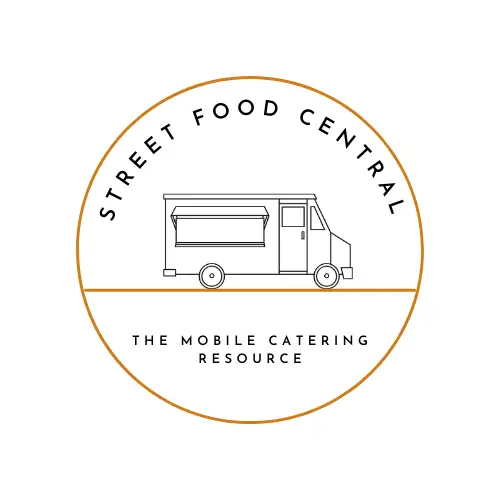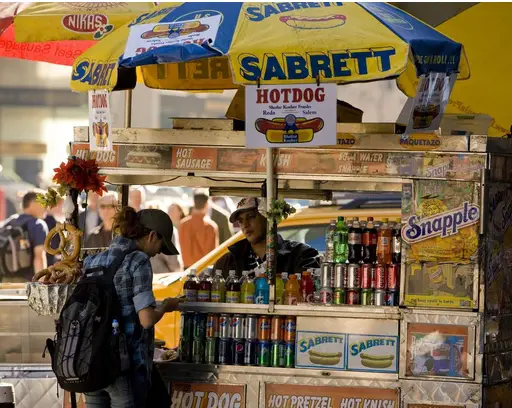Many people will not know this, but before I got started in the world of street food trucks, I first worked on a hot dog cart as a young man in New York. While I didn’t own the cart myself, it was still my first venture into street food as a whole and how the business works.
Starting a hot dog cart business involves several steps, including planning, obtaining permits, sourcing equipment and ingredients, marketing, and managing operations. Not only this, but it’s going to cost money too. In short, it’s going to cost you a minimum of $5000. Here’s a detailed guide, broken down into key steps, including costs and challenges:
1. Business Plan Development
- Objective: Define your business goals, target market, and unique selling proposition.
- This is going to be where you locate your hotdog cart, opening hours, and how much you will expect to sell per hour. Furthermore, if there are competing hotdog carts in the local area, you should figure out how you will compete against them. Competing on price alone is usually a losing proposition.
- Cost: Primarily time and effort; potential costs for market research and/or professional consulting.
- The main cost of opening a hotdog cart or stand is surprisingly going to be your own time. If you’ve never experienced this business before, it is no less hours than a full-time job, and realistically quite a lot more.
- If you conduct market research (which is strongly recommended), this is going to cost more time before you even begin to sell hotdogs.
- Challenge: Identifying a niche market and creating a business plan that is both realistic and profitable.
- As previously mentioned, your main challenge is to stand out from the crowd of other hotdog vendors – after all this is quite a basic food compared to other food trucks.
- The main ways to separate yourself from the competition will be the quality of the product (such as selling gourmet hotdogs), as well as the way you market and promote yourself on social media.
2. Legal Requirements and Permits
- Objective: Obtain necessary permits and licenses to operate legally.
- This is not a complicated or expensive process but does cost money. Different states have different rules and regulations, with some being a lot more expensive than others.
- Cost: Varies by location, approximately $100-$500.
- Challenge: Navigating local regulations and health department standards.
- As stated, some states require you to have various skills or certificates, as well as other licenses before you are legally allowed to handle street food such as hotdogs.
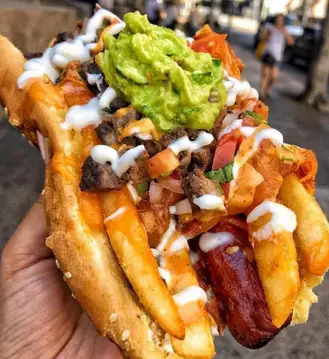
3. Financing
- Objective: Secure funding for initial investment.
- In terms of starting an offline business, opening a hotdog cart is one of the cheapest you can create. However, it still requires capital. As this is small, it can usually be obtained by simply working a job and saving money. It does not require loans or other investments.
- Cost: Depends on the scale; typically between $4,000 to $10,000.
- Buying a preowned hotdog cart will be significantly cheaper than buying brand new.
- Challenge: Getting loans or investments, especially with no business track record.
- If you do require a loan you will likely need collateral of some sort.
4. Purchasing a Hot Dog Cart
- Objective: Buy or lease a suitable hot dog cart.
- This is extremely easy and can be done by browsing Facebook marketplace, Craigslist, or if you have deeper pockets, buying brand new from a manufacturer.
- Cost: New carts range from $3,000 to $20,000; used carts may cost less.
- Challenge: Finding a reliable cart within budget that meets local regulations.
- It’s vital to find the local regulations within your city and state. Some states will only permit hotdog carts of certain sizes. You don’t want to purchase something too large and need a more complicated license to operate it.
5. Sourcing Ingredients and Supplies
- Objective: Procure quality hot dogs, buns, condiments, and other supplies.
- It’s best to take this part of the business very seriously as it is an ongoing task. If you’re successful, you’re going to need to buy supplies regularly, so it’s worth trying out a few suppliers to find out what works best for you, and more importantly, your customers.
- Cost: Approximately $500-$1,000 for initial stock.
- Challenge: Finding suppliers that offer quality products at competitive prices.
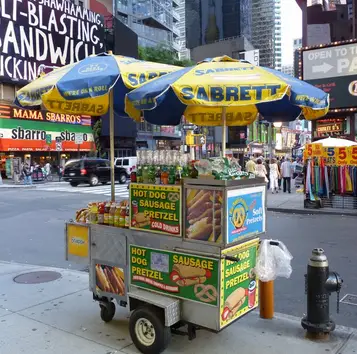
6. Location Scouting
- Objective: Identify high-traffic areas for setting up the cart.
- Another very important factor is finding out where you should set up your hot dog cart. Even the best salesman would struggle in a terrible location. Likewise, a poor salesman could thrive in an area with a lot of traffic.
- Cost: Potential fees for location permits.
- As an extreme example, vendors can pay over $200k to operate outside of Central Park in NYC.
- Challenge: Securing a lucrative spot with good visibility and foot traffic.
- Finding a good spot to set up is only half of the challenge, you will need to make sure that you’re legally allowed to sell in such a place.
7. Branding and Marketing
- Objective: Develop a brand identity and market your business.
- Thankfully this area of building a hotdog cat business is a lot easier than it was just 10 years ago. With various AI tools for naming and art, creating a brand is cheaper and faster than ever. It can be done in a matter of hours and for very minimal costs compared to paying humans.
- Cost: $200-$1,000 for initial branding and marketing materials.
- Challenge: Creating a distinctive brand and attracting initial customers.
- The real challenge is creating something memorable and different from the competition. This cannot be taught and requires a clever and creative mind.
8. Sales and Operations
- Objective: Operate the cart efficiently and provide excellent customer service.
- You must monitor your level of supplies and keep everything clean and tidy. After all, hot dog carts do not have a lot of space.
- Cost: Operational costs like gas, maintenance, and additional stock.
- Challenge: Managing day-to-day operations smoothly and maintaining quality.
- It is difficult to manage the physical job of preparing and selling food, as well as any other unknown challenges that will appear.
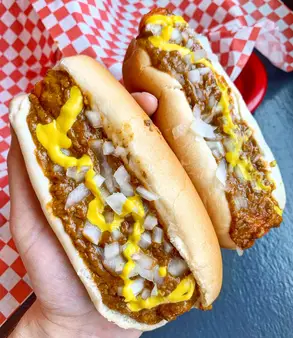
9. Financial Management
- Objective: Keep track of expenses and income to ensure profitability.
- It is vital to keep on top of everything. All expenses must be kept under control and you must know exactly how much money you’re making.
- Cost: Accounting software or professional services fees.
- Software such as Xero can be used to keep track of outgoings and income.
- Challenge: Efficiently managing finances and understanding cash flow.
- Even if your hotdog cart is profitable, failing to understand cash flow properly can still cause you to fail. Cashflow is the number one reason why small businesses fail.
10. Growth and Expansion
- Objective: Expand the business through additional carts or menu diversification.
- If you want to expand, this is by far the hardest part of this business. You must train and rely on other workers, as well as monitor everything that you are already doing. Of course, you do not have to expand your operation, but it is always an option.
- Cost and Challenge: Depends on business success and market conditions.
Breakdown of Initial Costs:
- Permits and Licenses: $100-$500
- Hot Dog Cart: $3,000-$20,000
- Initial Stock and Supplies: $500-$1,000
- Branding and Marketing: $200-$1,000
- Miscellaneous (Location Fees, etc.): Varies a lot
Main Challenges to Overcome When Owning A Hotdog Cart:
- Regulatory Compliance: Meeting health and safety standards.
- Location Constraints: Finding and securing profitable locations.
- Market Competition: Standing out in a competitive market.
- Financial Management: Balancing expenses and income for profitability.
- Customer Satisfaction: Consistently delivering quality products and services.
